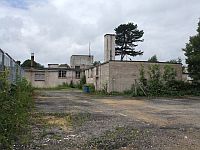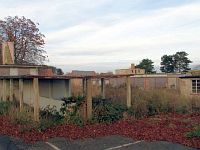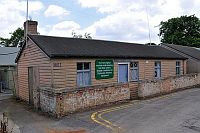
Bletchley Park awaiting renovation © Rob Farrow
I’ve highlighted the plight of The National Museum of Computing at Bletchley Park on more than one occasion, and given that it receives no proper government funding to support it – the odd bag of cash is thrown towards it from the Lottery – and depends on volunteers and contributions to keep it from collapsing altogether, maybe they should drop the National bit from their name.
As the Guardian’s computing correspondent puts it:
Bletchley Park is home to our digital heritage – it is a crying shame that the government won’t fund it
He’s just returned from a visit there, combined with a visit to the Computer History Museum in Mountain View, California, which he describes as being housed in a magnificent, award-winning modern building, with a 370-seat auditorium and rooms for classes and corporate events. By way of comparison, he describes Bletchley Park as being housed in dilapidated huts left over from the second world war.
He continues:
The Computer History Museum has a fairly substantial staff that includes a “vice president of capital campaign and principal giving” and a “senior director of corporate business development”. Its fundraising efforts try to exploit its proximity to local tech companies such as Google and Cisco, and local universities such as Stanford and the University of California’s campus at Berkeley.
TNMOC is run by volunteers, and there are no local computer giants. While Bletchley Park is close to the Open University HQ, OU’s students are rarely on campus.
As noted before, Bletchley is in need of at least £10 million to catch the decay and restore it to reasonable condition. A Save Bletchley petition attracted almost 22,000 signatures, but as the correspondent notes,”the polite government reply to that more or less decodes to ‘get stuffed’. Downing Street says English Heritage gave Bletchley £330,000 for roof repairs, and Milton Keynes council will provide ‘a further £600,000 for critical restoration work’.” This might sound like a fair amount of cash, but in reality is only enough to do patching, such is the age of the site, and the lack of funding it has suffered.
A valid point it made that the clock is ticking, and if the rot is not stopped, then it may be too late, and decaying parts of the site may pass the point where renovation is possible, and demolition becomes the only viable alternative – maybe someone is just waiting for that to happen.
This is coupled with an even more pressing need to do something before much more time passes. Many of the items on display are dependent on parts and components that are rapidly becoming obsolete and unavailable, either no longer manufacturer, or worse, being dumped from stores as they are of no practical value to the owners.
Yet more pressing is his observation that we are approaching a time where the pioneers that created many of the earliest computers will no longer be with is, and their knowledge needs to be preserved while it can still be gleaned from them.
Read the full article California dreamin’: a tale of two computer museums | Technology | The Guardian
I’ve lost count of the number of computers stored away in my back room. They date back to the dawn of practical home computing, and include microprocessor boards that wanted to be programmed in assembler and machine code – something I ran away from after the first few lost weekends – and some early Commodore and Amstrad offerings. There’s even a genuine Novell branded file server, notable in that it is a two-man lift, yet is little more than an 80286 based PC. In order to win back some space, I used 28 of the base units to support some shelving, and those shelves have more of the same tacked on them.
One of things that makes me smile nowadays is the all the fuss being made over the silly netbooks with their tiny screens, as if they were something new. I’m guessing I had the same capability on a laptop (and I acknowledge that it did not have wireless connectivity – but since there was no internet to connect to, that’s not really relevant). I had word-processing, spreadsheet, and database software running, and at an acceptable speed since there was none of today’s software bloat built into the code or operating system. Colour screens cost a fortune back them, so the grey-scale display meant that even with old-tech batteries, I still had about two hours operation without needing to find a mains socket.



 Only a few days after I noted that there is no real financial support for the National Museum of Computing (NMOC) at Bletchley Park in
Only a few days after I noted that there is no real financial support for the National Museum of Computing (NMOC) at Bletchley Park in 